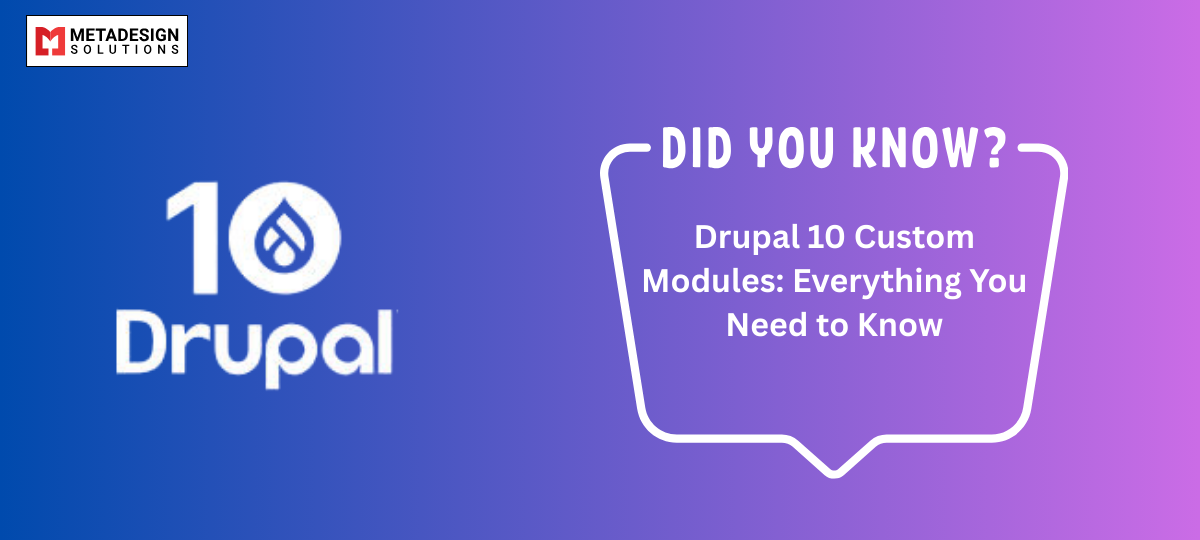Drupal 10 continues to be a robust and flexible content management system (CMS) that empowers developers to create tailored solutions through custom modules. These modules allow for the extension and customization of Drupal’s core functionalities to meet specific project requirements. As a leading Drupal development company, we specialize in building scalable, high-performance custom modules. This comprehensive guide delves into the essentials of Drupal 10 custom module development, covering structure, implementation, best practices, and advanced techniques to enhance your development workflow.
Understanding Drupal Modules
In Drupal, modules are packages of code that extend or alter the system’s functionality. There are three primary types:
- Core Modules: Included with the Drupal installation, providing fundamental features.
- Contributed Modules: Developed by the Drupal community and shared for public use.
- Custom Modules: Created by developers to address specific needs not met by core or contributed modules.
Custom modules are essential when unique functionality is required, ensuring that the CMS aligns precisely with project specifications.
Setting Up a Custom Module in Drupal 10
Creating a custom module involves several key steps:
1. Naming and Placing Your Module
- Machine Name: Choose a unique, lowercase machine name without spaces, adhering to Drupal’s naming conventions.
- Directory Structure: Place your module in the modules/custom directory of your Drupal installation.
2. Creating the .info.yml File
This file informs Drupal about your module’s existence and provides metadata. For example, a custom_module.info.yml file might contain:
yaml code:
name: 'Custom Module'
type: module
description: 'Provides custom functionality.'
package: Custom
version: 1.0
core_version_requirement: ^10
dependencies:
- drupal:views
Extend Your Drupal 10 Site with Custom Modules
Looking to add unique functionality to your Drupal 10 website? Schedule a consultation with MDS to develop tailored custom modules that meet your specific requirements.
This setup defines the module’s name, type, description, package grouping, version, core compatibility, and dependencies.
3. Implementing Hooks
Hooks are PHP functions that allow modules to interact with and modify Drupal’s behavior. They are a fundamental part of Drupal’s architecture. For instance, to alter a form, you might use hook_form_alter():
php code:
function custom_module_form_alter(&$form, \Drupal\Core\Form\FormStateInterface $form_state, $form_id) {
if ($form_id == 'specific_form_id') {
// Modify the form elements here.
}
}
This function checks for a specific form ID and allows you to alter its elements accordingly.
4. Utilizing Services and Dependency Injection
Drupal 10 leverages Symfony’s service container for managing services and promoting dependency injection. This approach enhances modularity and testability. For example, to use the entity_type.manager service in a custom service:
php code:
namespace Drupal\custom_module;
use Drupal\Core\Entity\EntityTypeManagerInterface;
class CustomService {
protected $entityTypeManager;
public function __construct(EntityTypeManagerInterface $entity_type_manager) {
$this->entityTypeManager = $entity_type_manager;
}
public function loadNodes() {
return $this->entityTypeManager->getStorage('node')->loadMultiple();
}
}
This class injects the entity_type.manager service to load multiple nodes, adhering to best practices for service usage.
Best Practices for Custom Module Development
Adhering to best practices ensures that your custom modules are efficient, maintainable, and secure:
- Coding Standards: Follow Drupal’s coding standards for consistency and readability.
- Separation of Concerns: Keep business logic separate from controllers and forms to enhance maintainability.
- Use of Hooks and Events: Implement hooks and subscribe to events judiciously to interact with Drupal’s core and other modules.
- Security Measures: Sanitize user inputs and utilize Drupal’s API functions to prevent security vulnerabilities.
- Configuration Management: Leverage Drupal’s configuration management system to handle module configurations effectively.
Advanced Topics in Custom Module Development
Creating Custom Field Types, Widgets, and Formatters
Drupal allows developers to define custom field types, widgets, and formatters to handle unique data requirements. This process involves creating plugins that extend Drupal’s field API. For example, a custom field type might be defined by implementing FieldItemBase, while a corresponding widget and formatter would extend WidgetBase and FormatterBase, respectively.
Subscribing to and Dispatching Events
With the integration of Symfony components, Drupal 10 utilizes an event dispatcher system. Modules can subscribe to core events or dispatch custom events to allow other modules to react to specific actions. For instance, subscribing to the kernel.request event enables a module to perform actions on every request:
php code:
namespace Drupal\custom_module\EventSubscriber;
use Symfony\Component\EventDispatcher\EventSubscriberInterface;
use Symfony\Component\HttpKernel\KernelEvents;
use Symfony\Component\HttpKernel\Event\RequestEvent;
class CustomEventSubscriber implements EventSubscriberInterface {
public static function getSubscribedEvents() {
return [
KernelEvents::REQUEST =>
::contentReference[oaicite:68]{index=68}
KernelEvents::REQUEST => 'onRequest',
];
}
public function onRequest(RequestEvent $event) {
// Perform custom logic on every page request.
\Drupal::logger('custom_module')->notice('Request intercepted at ' . date('Y-m-d H:i:s'));
}
}
To register your event subscriber, define a service in custom_module.services.yml:
yaml code:
services:
custom_module.event_subscriber:
class: Drupal\custom_module\EventSubscriber\CustomEventSubscriber
tags:
- { name: event_subscriber }
Routing and Controllers in Custom Modules
Routing is crucial for defining custom paths in Drupal.
Step 1: Define Routes
Create a custom_module.routing.yml file:
yaml code:
custom_module.hello:
path: '/custom/hello'
defaults:
_controller: '\Drupal\custom_module\Controller\HelloController::hello'
_title: 'Hello from Custom Module'
requirements:
_permission: 'access content'
Step 2: Create Controller
In src/Controller/HelloController.php:
php code:
namespace Drupal\custom_module\Controller;
use Drupal\Core\Controller\ControllerBase;
class HelloController extends ControllerBase {
public function hello() {
return [
'#markup' => $this->t('Hello, this is a custom route!'),
];
}
}
This approach allows you to define dynamic routes and render pages with Drupal’s render arrays or custom templates.
Creating Forms in Custom Modules
Drupal provides two types of forms:
- ConfigFormBase for admin config pages
- FormBase for regular forms
Example: Basic Contact Form
- Create CustomForm.php under src/Form:
php code:
namespace Drupal\custom_module\Form;
use Drupal\Core\Form\FormBase;
use Drupal\Core\Form\FormStateInterface;
class CustomForm extends FormBase {
public function getFormId() {
return 'custom_form';
}
public function buildForm(array $form, FormStateInterface $form_state) {
$form['name'] = [
'#type' => 'textfield',
'#title' => $this->t('Your Name'),
'#required' => TRUE,
];
$form['submit'] = [
'#type' => 'submit',
'#value' => $this->t('Submit'),
];
return $form;
}
public function submitForm(array &$form, FormStateInterface $form_state) {
\Drupal::messenger()->addMessage($this->t('Hello @name', ['@name' => $form_state->getValue('name')]));
}
}
2. Register the form via route or menu callback.
Working with Drupal 10 Configuration Management
Custom modules often require admin configuration. Drupal 10 provides a powerful configuration system using .yml files stored in config/install/.
Example: Creating a Config Schema
- Define a config schema in custom_module.schema.yml
- Create default values in config/install/custom_module.settings.yml
Use Drupal’s Config API to access and update configuration values:
php code:
$config = \Drupal::config('custom_module.settings');
$api_key = $config->get('api_key');
Testing and Debugging Custom Modules
1. Enable Error Logging
Use drupal_set_message(), \Drupal::logger(), and watchdog() for custom log messages. You can view them in the “Recent log messages” admin page (/admin/reports/dblog).
2. PHPUnit & Kernel Tests
Drupal supports both unit and functional tests. Place tests under /tests/src/Unit or /Kernel.
3. Devel Module
Install the Devel module for useful developer utilities, including:
- Variable inspection
- Route rebuilding
Execution time benchmarking
Security Best Practices
- Use Drupal’s Form API for validation and sanitization.
- Always use Twig autoescaping (never disable).
- Use user roles and permissions properly.
- Sanitize inputs and outputs with Html::escape() and Xss::filter().
- Validate CSRF tokens for custom forms using FormBase::getFormToken().
Performance Optimization Tips
- Cache data with the Cache API using cache_default bin or cache_render.
- Implement hook_page_attachments_alter() wisely to avoid unneeded JS/CSS.
- Use lazy builders and render caching.
- Avoid unnecessary DB queries in hooks like hook_init() or hook_page_top().
Real-World Use Cases of Custom Modules
- Integrating third-party APIs (payment gateways, CRMs, analytics)
- Creating custom entities for unique data models
- Extending core workflows, such as content publishing or moderation
- Building admin interfaces with custom dashboards
- Multisite shared modules, tailored per domain
Conclusion: Why Custom Modules Are Essential in Drupal 10
Drupal 10’s architecture encourages extensibility, and custom modules are your gateway to implementing features tailored to your business logic. By mastering:
- Drupal’s hook system
- Services and dependency injection
- Routing, forms, and controllers
- Configuration and event subscribers
- Testing and performance best practices
…you empower your team to build scalable, maintainable, and secure applications.
Whether you’re extending core functionality, building integrations, or creating reusable features, custom modules are the backbone of advanced Drupal development in 2025 and beyond. When combined with modern frontend approaches like Drupal 10 Theming with Tailwind CSS, these custom backend capabilities create a powerful, cohesive development stack—ensuring your Drupal projects are not only functional but also visually optimized and future-ready.
Related Hashtags:
#Drupal10 #DrupalCustomModule #DrupalDevelopment #CMSDevelopment #PHPModules #DrupalHooks #DrupalRouting #DrupalServices #OpenSourceCMS #BackendDevelopment



